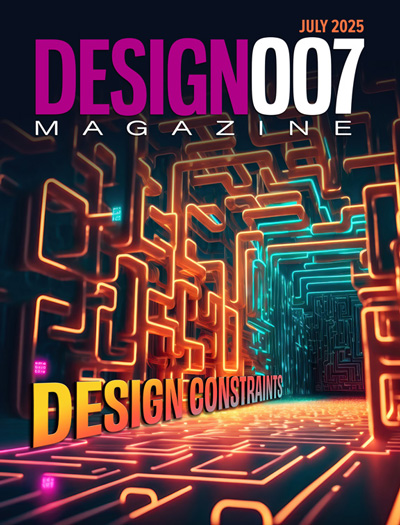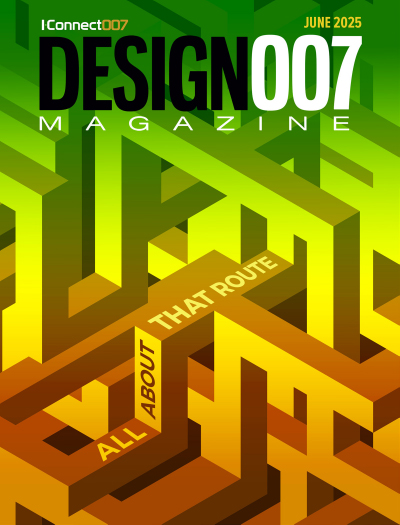-

- News
- Books
Featured Books
- design007 Magazine
Latest Issues
Current Issue
Proper Floor Planning
Floor planning decisions can make or break performance, manufacturability, and timelines. This month’s contributors weigh in with their best practices for proper floor planning and specific strategies to get it right.

Showing Some Constraint
A strong design constraint strategy carefully balances a wide range of electrical and manufacturing trade-offs. This month, we explore the key requirements, common challenges, and best practices behind building an effective constraint strategy.

All About That Route
Most designers favor manual routing, but today's interactive autorouters may be changing designers' minds by allowing users more direct control. In this issue, our expert contributors discuss a variety of manual and autorouting strategies.
- Articles
- Columns
- Links
- Media kit
||| MENU - design007 Magazine
Setting Design Constraints Effectively
July 31, 2025 | Stephen V. Chavez, Siemens EDAEstimated reading time: 1 minute
PCB design requires controlling energy within the medium of a PCB. The manner in which we control the chaos of energy is by implementing and utilizing physical and electrical rules, known as constraints, along with a specific structure and material(s) that make up what is known as the foundation of the design. These rules govern everything within the PCB structure and generally fall into two camps: performance and manufacturability. Setting this foundation correctly is extremely important and the key to success.
At times, especially with very complex designs, it’s no easy task to make sense of these rules while creating and implementing these design constraints. It can be daunting and time-consuming. How many times during the initial phase of the design process have we heard project management ask, “What is taking so long? Why haven’t you started placing components and routing? Why do you even need constraints?”
I’m sure many can relate to such questions. The goal for any PCB design is to be “correct by construction,” where you have the highest potential for first-pass success. This means that revision 1 works with no respins required, and there are no interruptions in the process of getting the product to market as fast as possible. This is accomplished by implementing and utilizing design constraints along with industry best practices, which are vital toward achieving PCB design success.
Design constraints are typically derived from customer requirements. Depending on the intended function of the end product, how it needs to function and under what conditions it needs to operate are the keys to deriving the specific details of the actual constraints to be implemented in your design. Make sure you work closely with your manufacturers (both fabrication and assembly) from the very beginning of the project and throughout the design process. I cannot stress enough that close collaboration with your manufacturers, also known as your external stakeholders, is key to downstream success.
To continue reading this article, which originally appeared in the July 2025 issue of Design007 Magazine, click here.
Testimonial
"Advertising in PCB007 Magazine has been a great way to showcase our bare board testers to the right audience. The I-Connect007 team makes the process smooth and professional. We’re proud to be featured in such a trusted publication."
Klaus Koziol - atgSuggested Items
New Episode Drop: MKS’ ESI’s Role in Optimize the Interconnect
08/21/2025 | I-Connect007In this latest episode, Casey Kruger, director of product marketing at MKS’ ESI, joins On the Line With… host Nolan Johnson to share how CO₂ laser technology delivers faster, more accurate vias in a smaller, more energy-efficient footprint.
PEDC Call for Abstracts Deadline Extended to Aug. 31
08/20/2025 | I-Connect007 Editorial TeamThe second Pan-European Electronics Design Conference (PEDC) will take place Jan. 21-22, 2026, in Prague, Czech Republic. The call for abstracts deadline has been extended to Aug. 31. Organized jointly by the German Electronics Design and Manufacturing Association (FED) and the Global Electronics Association (formerly IPC), PEDC serves as a European platform for knowledge exchange, networking, and innovation in electronics design and development.
How Good Design Enables Sustainable PCBs
08/21/2025 | Gerry Partida, Summit InterconnectSustainability has become a key focus for PCB companies seeking to reduce waste, conserve energy, and optimize resources. While many discussions on sustainability center around materials or energy-efficient processes, PCB design is an often overlooked factor that lies at the heart of manufacturing. Good design practices, especially those based on established IPC standards, play a central role in enabling sustainable PCB production. By ensuring designs are manufacturable and reliable, engineers can significantly reduce the environmental impact of their products.
Meet the Round 1 Winners of the Bright Manufacturing Student Challenge 2025
08/20/2025 | Tara Dunn, SMTAThe Bright Manufacturing Student Challenge is an opportunity for student teams to design and develop innovative solutions for real-world electronics manufacturing problems. The eight-week competition, sponsored by the Electronics Manufacturing & Assembly Collaborative (EMAC) through electronicsworkforce.com, allows students to showcase their technical skills, creativity, and problem-solving abilities.
University Of Minnesota Team Claims Victory In Bright Manufacturing Challenge 2025 Round 1
08/19/2025 | EMACThe Electronics Manufacturing & Assembly Collaborative (EMAC) recently announced that Team "Rise and Grind Crew" from the University of Minnesota has emerged victorious in Round 1 of the Bright Manufacturing Challenge 2025.


